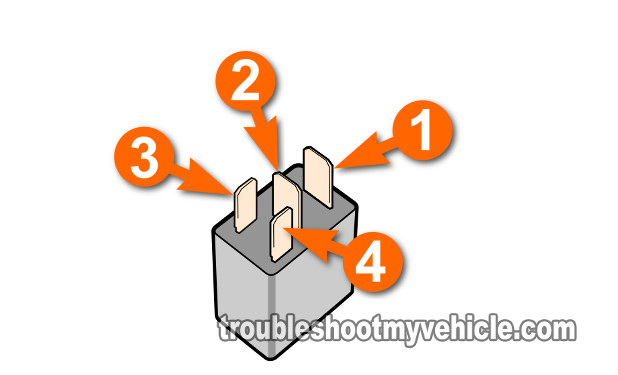TEST 3: Bypassing The Radiator Fan Switch
So far, if you've reached this step, you have verified that the radiator fan motor is getting power in the appropriate socket terminals.
In this test step, you'll re-install the radiator fan motor relay and then unplug the radiator fan switch and bypass it with a jumper wire.
This is a very simple test but you do need to take one very important precaution and it's to use a small diameter jumper wire (gauge-wise).
This is to prevent the jumper wire from damaging the radiator fan switch's pigtail connector's female terminals.
NOTE: The radiator fan switch is located on the thermostat housing, see image 2 of 2 above.
OK, this is what you need to do:
- 1
Disconnect the radiator fan motor switch from its pigtail connector.
NOTE: The radiator fan relay must be in its place on the under-hood fuse box for this test to work. Also, your Honda's engine should be cold to avoid burns. - 2
Jumper the pigtail connector's 2 terminals.
IMPORTANT: Use the smallest diameter wire to jumper these two circuits. If you use anything thicker (gauge-wise) you could permanently damage the female metal terminals. - 3
Turn the ignition switch to the ON position, but don't start the engine (this test is done with the Key On Engine Off -KOEO).
- 4
The radiator fan motor should activate, as soon as you turn the key to the ON position (KOEO).
NOTE: Remember, the radiator fan motor has to be in its place on the under-hood fuse block for this test to work.
Let's interpret your test results:
CASE 1: The radiator fan motor came on. This is the normal and expected test result.
By seeing your Honda Civic's radiator fan run, you have confirmed that:
- The radiator fan motor relay is good (otherwise the fan would not have turned on).
- The two fuses that supply battery power to the radiator fan relay are NOT blown (otherwise the fan would not have come on).
- The wires (circuits) between the fan switch and radiator fan motor relay are not shorted or open (otherwise the fan would not have come on).
- The wires between the radiator fan motor and radiator fan motor relay are not shorted or open (otherwise the fan would not have come on).
Therefore, if your 1.7L Honda Civic is overheating (and the radiator fan motor is not coming on), you can correctly deduce that the fan motor switch is bad and needs to be replaced.
CASE 2: The radiator fan motor DID NOT come on. Recheck your jumper wire connections and retest.
If your Honda Civic's radiator fan motor does not come on, then you have eliminated two important components as bad:
- The radiator fan motor.
- The radiator fan motor switch.
You can deduce that the radiator fan relay is bad since you have:
- Done TEST 1 and have confirmed that relay socket terminals #2 and #3 are feeding battery power to the relay.
- Done TEST 2 and the fan came on when you jumpered the relay socket terminals #1 and #2.
Suggestion: If I where in your shoes, I would now swap this relay with another on the fuse box and repeat this same test. If your Honda Civic's fan motor now comes on, I now know that the radiator fan relay is truly fried. You can also bench-test the radiator fan motor relay using the steps described in TEST 4.
TEST 4: Bench Testing The Radiator Fan Relay
In this last section, I'll show you how you can bench-test your Honda Civic's radiator fan relay by manually applying battery power and Ground to it and seeing if circuit #1 and #2 show continuity (as tested with a multimeter).
The illustration above is an actual example of how your jumper wire and multimeter test lead connections should look like.
NOTE: The power and Ground source that you'll be using is your Honda Civic' car battery.
These are the test steps:
- 1
Connect male spade terminal #4 to Ground, using one of your jumper wires.
- 2
Connect male spade terminal #3 to the battery's positive (+) terminal. This will energize and activate the relay. This can be confirmed by the audible click the radiator fan relay will make.
- 3
Measure the resistance across the relay's terminals #1 and #2 with your multimeter in Ohms mode (as seen in the photo).
- 4
Your multimeter should show continuity. If it doesn't show continuity, recheck all your connections and retest.
- 5
Remove and reconnect the jumper wire to terminal #3 several times, as you eye-ball the multimeter.
When the jumper wire IS NOT connected to power, the multimeter should show NO CONTINUITY.
When the jumper wire is connected to power, the multimeter should show continuity.
Alright, let's take a look at your test results:
CASE 1: Your multimeter showed continuity. This test result tells you that the radiator fan relay is good.
CASE 2: Your multimeter DID NOT show continuity. Recheck all of your test connections and retest. If your multimeter still doesn't show continuity, then the radiator fan relay is fried and needs to be replaced.
Where To Buy The Radiator Fan Relay And Save
You don't have to spend more than you have to on your Honda Civic's replacement part needs.
Below, in the boxes, are links to the radiator fan motor relay, radiator fan motor, the radiator fan switch, and the radiator, which you can check out and compare.
In case you're wondering if these parts fit your specific Honda, once you click on the links and reach the website, they'll ask you for the specifics of your Honda and either confirm that they fit or will help you find the right parts.
Disclosure: As an Amazon Associate, I earn from qualifying purchases. If my tutorials help you, using these links is an easy way to support the site at no extra cost to you. Thank you!
More Honda Civic Test Tutorials
You can find a complete list of Honda Civic tutorials in this index: 1.7L Honda Civic Index Of Articles.
Here's a small sample of the tutorials you'll find in the index:
- How To Test The Crank Sensor (2001-2005 1.7L Honda Civic).
- Maintenance Required Light Reset (2001-05 1.7L Honda Civic).
- How To Do A Cylinder Balance Test (2001-2005 1.7L Honda).
- How To Test Trouble Code P0141 (2001-2005 Honda 1.7L).
- How To Test The TP Sensor (2001-2005 1.7L Honda Civic).
- How To Test Trouble Code P0135 (2001-2003 Honda 1.7L).

If this info saved the day, buy me a beer!










